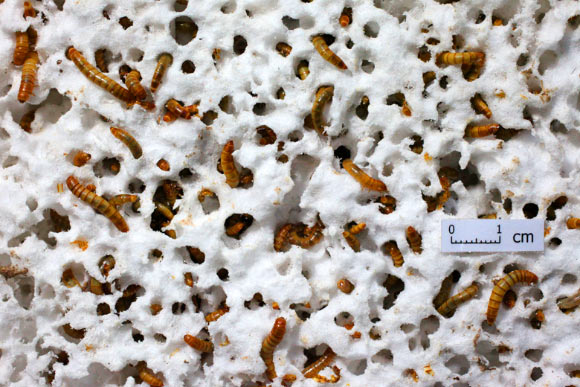Mealworms, which are the larvae of the darkling beetle (Tenebrio molitor), can subsist on a diet of Styrofoam and other forms of polystyrene, according to a team of researchers from China and the United States.

Mealworms (larvae of the darkling beetle) munch on Styrofoam, a hopeful sign that solutions to plastics pollution exist. Image credit: Yu Yang.
“Mealworms from different sources chew and eat Styrofoam, a common polystyrene product,” the scientists said.
“The Styrofoam was efficiently degraded in the larval gut within a retention time of less than 24 hours. Fed with Styrofoam as the sole diet, the larvae lived as well as those fed with a normal diet over a period of one month.”
Their two papers, published online in the journal Environmental Science and Technology, are the first to provide detailed evidence of bacterial degradation of plastic in an animal’s gut.
In the lab, 100 mealworms ate between 34 and 39 milligrams of Styrofoam per day. The worms converted about half of the Styrofoam into carbon dioxide, as they would with any food source.
Within 24 hours, they excreted the bulk of the remaining plastic as biodegraded fragments that look similar to tiny rabbit droppings.
“Mealworms fed a steady diet of Styrofoam were as healthy as those eating a normal diet and their waste appeared to be safe to use as soil for crops,” said co-author Dr Wei-Min Wu of Stanford University.
The team also investigated the role of the mealworms’ gut bacteria in Styrofoam degradation.
“Gentamicin was the most effective inhibitor of gut bacteria among six antibiotics tested. Gut bacterial activities were essentially suppressed by feeding gentamicin food for ten days,” the researchers explained.
“Gentamicin-feeding mealworms lost the ability to depolymerize polystyrene and mineralize it into carbon dioxide.”
The scientists managed to isolate a polystyrene-degrading bacterial strain, Exiguobacterium sp. YT2, from the guts of the mealworms.
“Our findings have opened a new door to solve the global plastic pollution problem,” Dr Wu said.
In earlier research, they have shown that waxworms (caterpillar larvae of Indian mealmoths) have microorganisms in their guts that can biodegrade polyethylene.
The team now plans to study whether microorganisms within mealworms, waxworms and other insects can biodegrade plastics such as polypropylene, microbeads and bioplastics.
_____







